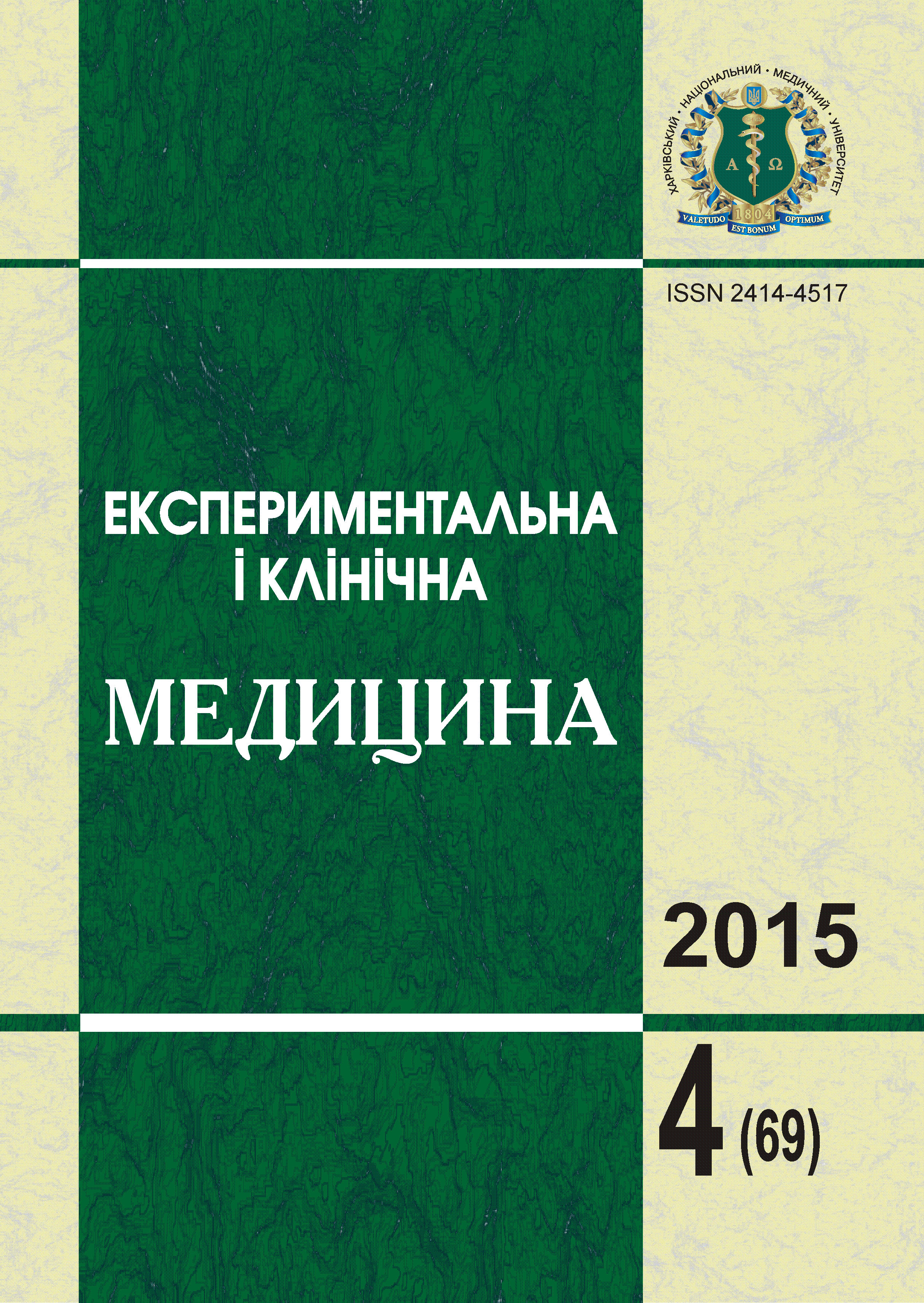Abstract
The article presents the clinical and laboratory data of the two fatal cases. In one of them developed acute respiratory distress syndrome on the background of the influenza A (H1N1) pdm09, in the other – community-acquired pneumonia due to Klebsiella pneumonia. There is detailed description of the clinical manifestations of disease. There was described pathologic changes mainly in the lungs. In a comparative perspective the characteristic morphological changes in the lung tissue in the community-acquired pneumonia due to Klebsiella pneumonia and ARDS caused by. Clinical and pathologic analysis of fatal outcomes, the analysis of the criteria of systemic inflammatory response syndrome and indicators characterizing leukocyte index of intoxication while in the intensive care unit patients were made. Both patients significantly increased leukocyte intoxication index, the index of resistance of the body is reduced to a greater extent with the flu, and the reactive response of neutrophils – pneumonia caused by Klebsiella pneumonia. Adverse prognostic clinical and laboratory factors was marked.References
Taubenberger J.K. Influenza viruses: breaking all the rules Jeffery / J.K. Taubenberger, D.M. Morens // MBio. – 2013. – Vol. 4, № 4. − DOI: 10.1128/mBio.00365-13. http://mbio.asm.org/content/4/4/e00365-13
Pulmonary pathologic findings of fatal 2009 pandemic influenza A/H1N1 viral infections // James R. Gill, Zong-Mei Sheng, Susan F. Ely et al. // Arch. Pathol. Lab. Med. – 2010 Feb. – Vol. 134 (2). – P. 5.
Адаптована клінічна настанова, заснована на доказах. Грип та гострі респіраторні інфекції // Журнал «Актуальная инфектология». – 2014. – № 3 (4). – С. 123–191.
Morens D.M. Predominant role of bacterial pneumonia as a cause of death in pandemic influenza: implications for pandemic influenza preparedness / D.M. Morens, J.K. Taubenberger, A.S. Fauci // J. Infect. Dis. – 2008 Oct 1. – Vol. 198 (7). – P. 962–970, doi: 10.1086/591708.
2009 Pandemic influenza A (H1N1) pathology and pathogenesis of 100 fatal cases in the United States // Am. J. Pathology. – 2010, July. – Vol. 177, № 1, American Society for Investigative Pathology DOI: 10.2353/ajpath.2010.100115
Histopathological autoptic findings in 8 patients with pandemic influenza A (H1N1) pneumonia / H. Skalova, C. Povysil, J. Hofmanova et al. // Patol. – 2012. – Vol. 48 (3). – P. 161–164.
Histopathological and immunohistochemical findings of 20 autopsy cases with 2009 H1N1 virus infection / N. Nakajima, Y. Sato, H. Katano et al. // Mod Pathol. – 2012, Jan. – Vol. 25 (1). – P. 1–13. doi: 10.1038/modpathol.2011.125. Epub 2011 Aug 26
Патологическая анатомия гриппа A/H1N1 / А.Л. Черняев, О.В. Зайратъянц, Н.И. Полянко и др. // Архив патол. – 2010, май-июнь. – Т. 72, № 3. – С. 3–6.
Acute respiratory distress syndrome and pneumonia: A comprehensive review of clinical data // T.T. Bauer, S. Ewig, A.C. Rodloff, E.E. Muller // Clinical Infectious Diseases. – 2006. – Vol. 43. – P. 748–756, CID 2006:43 (15 September) Сlinical practice Р. 748–756.
Лискина И.В. Гистоморфологическая характеристика идиопатических интерстициальных пневмоний / И.В. Лискина, Н.Е. Моногарова // Український пульмонологічний журнал. – 2007. – № 4. – С. 37–43.
Фещенко Ю.И. Идиопатические интерстициальные пневмонии: классификация, дифференциальная диагностика / Ю.И. Фещенко, В.К. Гаврисюк, Н.Е. Моногарова // Український пульмонологічний журнал. – 2007. – № 2. – С. 5–11.
Острая интерстициальная пневмония / С.И. Авдеев, А.Л. Черняев // Медицина неотложных состояний. – 2006. – № 5 (6). – С. 24–27.
Новиков Н.Ю. Патоморфологические различия острого респираторного дистресс-синдрома первого и второго типа / Н.Ю. Новиков // Клінічна та оперативна хірургія. – 2012. – Т. 11, № 2. – С. 88–90.
Follow-up after acute respiratory distress syndrome caused by influenza a (H1N1) virus infection / C.Jr. Toufen, E.L. Costa, A.S. Hirota et al. // Clinics (San Paulo). – 2011. – Vol. 66, № 6. – P. 933–937.
Salihefendic N. Acute respiratory distress syndrome (ARDS) from endemic influenza A/H1N1: Prehospital Management / N. Salihefendic, M. Zildzic, S. Ahmetagic // Med. Arch. – 2015. – Vol. 69, № 1. – P. 62−63.− DOI:10.5455/medarh.2015.69.62-63
Глумчер Ф.С. Острый респираторный дистресс-синдром: определение, патогенез, терапия / Ф.С. Глумчер // Мистецтво лікування. – 2004. – № 9. – С. 30–35.
Mechanisms of neutrophil accumulation in the lungs against bacteria / Gayathriy Balamayooran, Sanjay Batra, Michael B. Fessler et al. // Am. J. Respir. Cell Mol Biol. 2010, Jul. – Vol. 43 (1). – P. 5–16. – Published online 2009 Sep 8.doi:10.1165/rcmb.2009-0047TR
ARDS and influenza A (H1N1): patients characteristics and management in intensive care unit. A literature review / S. Jaber, M. Conseil, Y. Coisel et al. // Ann. Fr. Anesth. Reanim. – 2010. – Vol. 29, № 2. – P. 117−125.− DOI:10.1016/j.annfar.2009.12.026
Standiford T.J. Therapeutic targeting of acute lung injury and acute respiratory distress syndrome / T.J. Standiford, P.A. Ward // Transl. Res. – 2015. − DOI:10.1016/j.trsl.2015.04.015.
Shtabnitskiy V.A. Acute respiratory distress syndrome: how to optimize oxygen transport and to improve prognosis / V.A. Shtabnitskiy, A.G. Chuchalin // Ter. Arkh. – 2014. – Vol. 86, № 11. – P. 115−122.
The American-European Consensus Conference on ARDS. Definitions, mechanisms, relevant outcomes, and clinical trial coordination /G.R. Bernard, A. Artigas, K.L. Brigham et al. // Am. J. Respir. Crit. Care Med. – 1994. – Vol. 149, 3 pt 1. – P. 818–824.
The ARDS Definition Task Force. Acute respiratory distress syndrome: the Berlin Definition // JAMA. – 2012, June 20. – Vol. 307, № 23. – Р. 2526–2533. doi: 10. 1001/jama.2012.5669
Risk factors for the development of acute lung injury in patients with infectious pneumonia // M. Kojicic, G. Li, A.C. Hanson et al // Critical Care. – 2012. – Vol. 16, is. 2: R46.http://ccforum.com/content/16/2/R46. Р.9
Рекалова Е.М. Поражения легких в период пандемии свиного гриппа А (H1N1) 2009–2010 гг / Е.М. Рекалова // Журнал Клиническая иммунология. Аллергология. Инфектология. – 2010, сентябрь. – № 3. – С. 42–48.
Acute respiratory distress syndrome: prevention and early recognition / Candelaria de Haro, Ignacio Martin-Loeches, Eva Torrents, Antonio Artigas // Annals of Intensive Care. – 2013. – Vol. 3, № 11. – http://www.annalsofintensivecare.com/content/3/1/11. PMC3639084. doi: 10.1186/2110-5820-3-11
